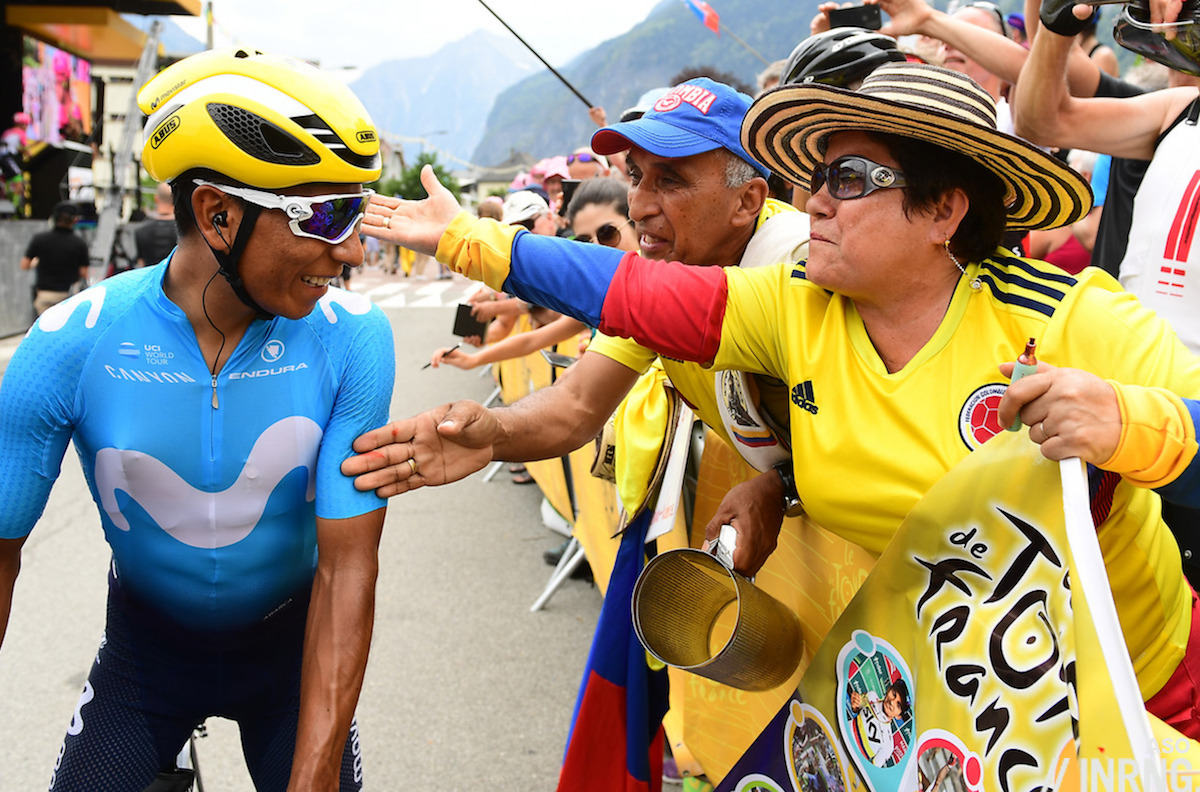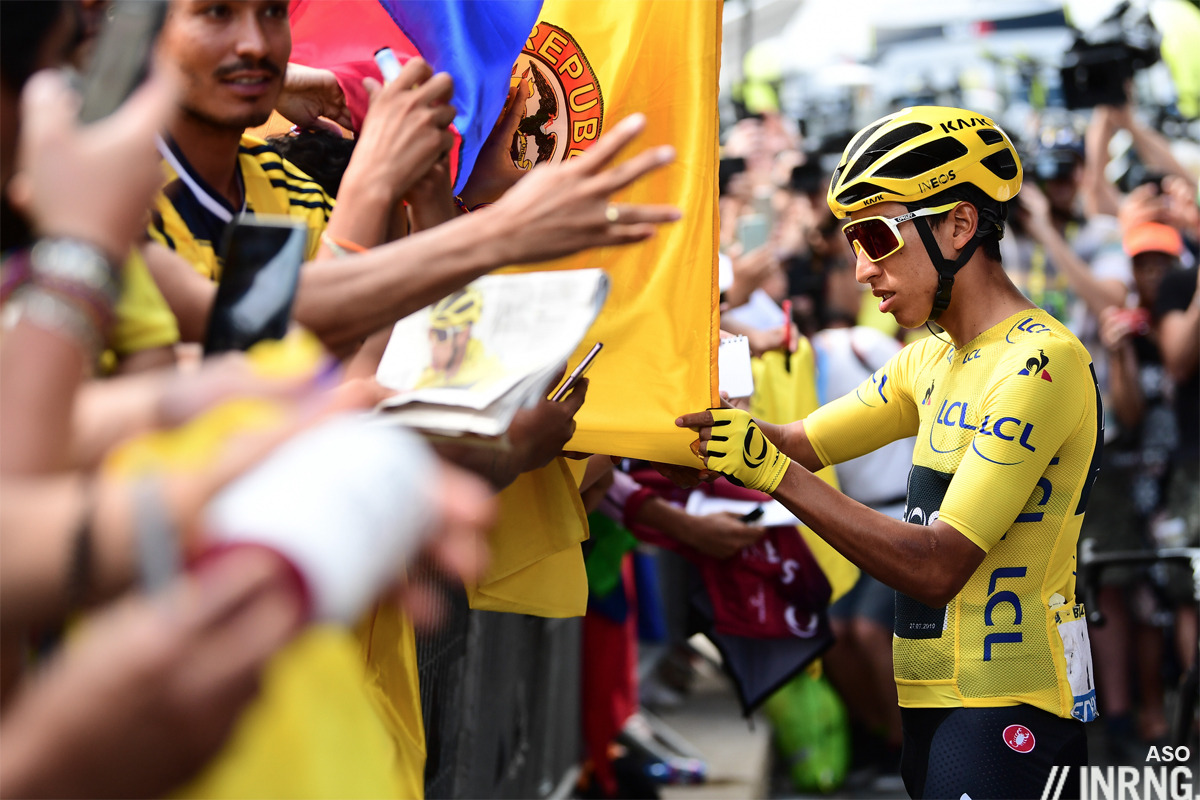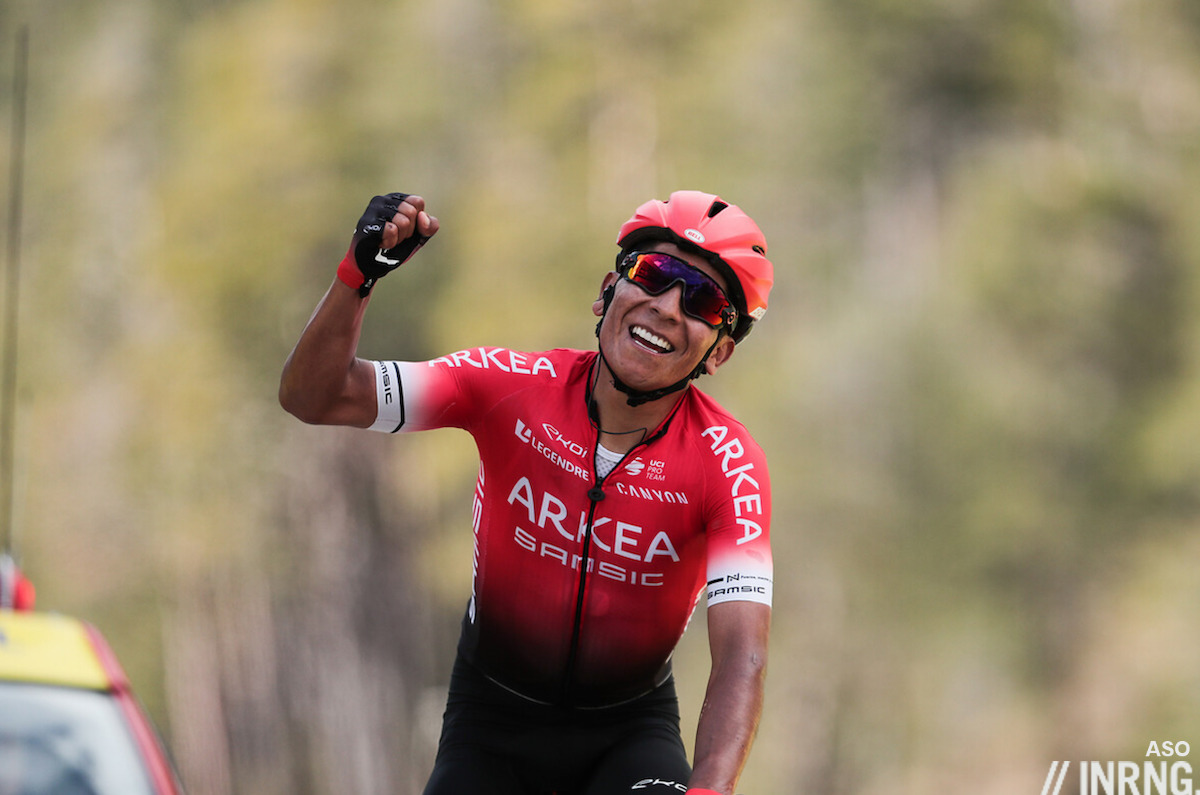“Colombia Es Pasión” by Matt Rendell
A biography of several Colombian cyclists as well as the story of modern Colombian cycling and Colombia itself, this book will enrich your understanding of many of today’s top riders and the arduous paths they’ve taken to reach the top of their sport.
Rendell wrote “Kings of the Mountains” in 2003 which covers more of Colombia’s early cycling history, that is if you can get your hands on it, as it is out of print and scarce second-hand copies trade at a premium. Now “Colombia Es Pasión” is the story of today’s generation, the biography of contemporary Colombian riders plus Richard Carapaz, the Ecuadorian who was raised on the porous border and did much of his early racing in Colombia.

Did you know Miguel Angel Lopez is nicknamed “Superman” because he fought off thieves who tried to take his bike? That Esteban Chaves had a near-miraculous recovery from crash injuries? That Rigoberto Uran’s father was murdered? That Nairo Quintana campaigns for rural rights? That Alvaro Hodeg’s surname should be Hodge as he’s descended from a Scotsman? That Egan Bernal started out mountain biking? If you didn’t, then this book will recount these stories and plenty more. If you knew all of this already, fear not as this book will give you details galore.
Let’s take the example of Lopez, the book explains he was on his mountain bike to buy credit for his phone when two men set on him and he fought them off, it then tells how he struggled to get medical attention for the knife wound, going from clinic to hospital until one finally attended to him. In this tale we have part of Lopez’s legend and the origins of his nickname but also a story of Colombia from bandits trying to rob a child’s bike, and one of weak healthcare: the micro and macro. Such detail evokes Rendell’s “The Death of Marco Pantani” but that was forensic like a post mortem, in “Colombia Es Pasión” the information just enriches the story and signals the author has done their research on the ground, rather than recycle press cuttings into book.

Several themes run throughout. A chapter about a rider often cites the family finca and what they grow (sugar cane and maize for the machete-wielding Dani Martinez; potatoes, onions, sweetcorn, peas, beans, fava and haricot for Miguel Angel Lopez; maize, beans, potatoes, carrots, cabbage, wheat and barley for Darwin Atapuma’s family; maize, potatoes, beams, peas, tamarillo and arracacha for Fernando Gaviria’s grandfather), these are sons of the soil and it’s rarely bucolic, volatile crop prices can be ruinous, while rebels and paramilitaries threaten livelihoods and life.
Ethnicity and skin tone feature, outwardly we see riders under the Colombian flag, sometimes we know riders come from rival regions like Boyaca or Antioquia but they’re not homogeneous. Quintana’s mother is a muysca, an indigenous people, Atapuma is a proud pasto. Alvaro Hodeg Chagui is descended from Scottish and Syrian ancestors.
It’s become common to think Colombia confers advantage on its cyclists thanks to the effects of high altitude but read this and it’s a constant struggle, pasión as in patience and pathos. Many of today’s stars start racing on old bikes, there’s no vintage charm, just heavy iron and many struggled for basic cycling kit. Darwin Atapuma has to decide between his cow and a new bike, a modern version of Jack and the Bean Stalk:
Darwin has a cow and weaning calf at the finca… But Darwin faces a dilemma. He needs light, modern racing bike. Without it, his chances of winning the 2004 Vuelta del Porvenir, the national stage race for seventeen- and eighteen-year-olds, will be slim. But if he sells his cow, he disposes of his only source of income.
Egan Bernal’s parents flee a violent, impoverished barrio for another where “the roads were still unpaved, and their house lacked a roof and floors, but the move represented a small but significant step up” and Bernal’s cycling career might have been over before it started as his parents couldn’t afford the 50 cent entry fee for a kid’s race. Rigoberto Uran’s father is murdered, leaving “Rigo” as the family breadwinner as a teenager, a brutal case but several other star riders spend their early years toiling on farms or starting work before dawn loading trucks with produce before school. What’s startling is how recent much of this is, the rider you saw in team kit on a €10,000 bike recently may well have been picking strawberries for €1.50 a day a few years ago while their Euro peers in the peloton graced university benches or were paid salaried by U23 teams. As Rendell explains, concepts of childhood and adolescence are vague in Colombia.
Riders and their families are often campesinos, peasants. The word shares its linguistic roots with campeón, champion. The resilience needed to cope with this difficulty perhaps explains the popularity of cycling in Colombia, the hours of outdoor work, the patience. It certainly gives many of these Colombian cyclists a sense of perspective and Nairo Quintana’s journey from Cómbita to Monaco is measured in more than a circumference of 9,000km.

There’s an element of survivor bias here. The stars we see atop podiums obscure the plenty who didn’t make it, perhaps equally talented but their bikes broke, they crashed, or traffic accidents damaged them. Most often they and their entourage could never raise the pesos needed to race. Here Colombia’s cycling federation doesn’t come out of the book well, far from Quintana or Bernal being the peak of a broad pyramid, they seem to resemble angels decorating a wilted, barren Christmas tree. Escaping Colombia sounds essential, as to stay is to risk falling into the seemingly rampant domestic doping scene where testing is rare, Oscar Sevilla keeps winning, and according to one claim in the book, positive tests could be suppressed for a cash payment. If riders have made it to the top it’s often despite the formal institutions meant to help. When President Santos congratulated Colombian riders for their display in the 2016 Tour de France, Winner Anacona replied they did it with little help from others:
volveremos por+,porq nos hemos hecho SOLOS en este bonito y duro deport con la ayuda de pocos.
— Winner Anacona (@wian88) July 23, 2016
Rendell is an evangelist for Colombia. A background story is Colombia’s path towards peace and prosperity, it’s gone from a place to be avoided to one where you might like to ride. There’s affection to the riders, they’re referred to by their first names and “Nairo” especially can do no wrong, the controversy over his Giro-winning move over the snowy Stelvio in 2014 is down to confusion by the race organisers and whipped up by rival teams; his stale period of late at Movistar as if he had no power in picking his race programme and so on. But read and you’ll be sympathetic to Quintana, even the section of the crowd that accuses him of being passive in races might warm to him given the obstacles he’s overcome.

Being greedy you’re left wanting even more, for example to learn more about how Colombians follow cycling in the media and what place cycle sport holds in the country today, do people still listen to radio broadcasts while toiling in the fields or do they “consume” cycling via Uran’s Instagram feed? Or are there two very different classes now? This change is touched on at the end of the book, as consumer brands stake out the climb of Las Palmas during the Tour Colombia.
Colombia Es Pasión was marketing slogan created to brand Colombian exports and you wonder if the book title is right, does “passion” match the story of riders escaping a weary, insecure land? Perhaps it’s the writer’s passion? Or the esoteric meaning used in Christianity, the passion as a calvary. Then you think of all the volunteers, the people running clubs in their spare time, the coaches paid a pittance to keep kids busy and here’s the passion, this quiet network that has helped export these riders and create mini-ambassadors to promote Colombia. Luis Saldarriaga stands out, the book is a generous tribute.

The Verdict
Enjoyable, authentic and thorough, “Colombia Es Pasión” tells the story of several Colombian cyclists, of modern Colombian cycling and through them, the recent story of a nation.
Sometimes the publishing industry can work backwards, “Va Va Froome” felt pumped out in time for Chris Froome’s first Tour win and other books seemed timed to meet forecast demand for themes and anniversaries. Colombia Es Pasión doesn’t feel like a reaction to the rise of Egan Bernal, Nairo Quintana or Fernando Gaviria, it’s more a labour of love and much the better for it. It’s an easy read, especially if you have prior cycling knowledge, the biographies of each rider tell interweaving stories and help bring pace to the book as it skips from rider to rider, this prevents the story get bogged down on background politics and conflicts.
It retails for £20 in the UK, pricey, but worth reading for all the insight it contains, it’s a volume of biographies in one that will give a deeper appreciation of today’s Colombian cyclists and their journeys.
- Colombia Es Pasión is published by Weidenfeld & Nicolson/Orion and available in hardback, electronic and audiobook versions


English?
A Coloradoan, I can relate to many European race rider stories.
It’s harder to imagine life as a growing cyclist in Columbia.
Yes it’s in English. The background and struggles aren’t unique to Colombians, plenty of Kazakhs have it tough, even more so Eritreans and so on but at least Colombia has some culture, structures and races, there are proven paths but the details in the book are illuminating, you might know Quintana grew up in modest surroundings but the book has space to explain the difficulties his family encountered.
Matt Rendell brings a very thorough journalistic approach to almost everything he pens. Does he get to the bottom of Nairo’s true age?
Thanks for the review.
Isn’t a thorough journalist an oxymoron these days? 🙂
Rendell’s thoroughness speaks far more of his background in academe and ‘Kings of the Mountains’ has a front cover quote from the TLS. Not too many cycling books get that accolade and there is a density in some of its prose of which many university lecturers would be proud. It’s not always the easiest of reads. Anybody thinking of paying the silly prices being asked by booksellers for that work, undoubtedly an excellent book and worth the effort of tracking down, should have a look at the last two sold items on ebay.co.uk. Both went for less than £10.
I have to agree with you on the basis of his Marco Pantani biography. The majority of that book reads very much like a scientific deconstruction to extricate ‘the truth’ behind a very polarising character who has been somewhat mythologised. It felt like an autopsy in large parts, with a something of a human flourish towards the end.
However, I really valued this careful examination of Pantani. A much more journalistic approach would probably have put much more emotional content into building Pantani’s legend and therefore the sadness of his tragic death, and to that extent been a hagiography of sorts (a book by someone that was not enamoured by Pantani would likely not be a seller). But Rendell stayed the course to ensure we understand the gritty ugly underbelly of truth to the Pantani story. That for every mythic performance there was a needle, an enabler and a boy from a poor background making the most of his opportunities.
There’s a bit on his appearance and looks but if anything he’s older and wiser in the mind and was forced to grow up early, setting up the family market stall at dawn etc. All the riders had to grow up a lot earlier than most of their peers in the peloton, Bernal’s chapter is titled “The boy who grew up too fast”.
I’ve always liked Matt Rendell (his Blazing Saddles is a favourite of mine) but I’ve occasionally thought his long-standing admiration for Colombian cyclists, especially ‘wonderful Nairo’, does cross the line into fan-with-typewriter territory. That said, a book like this does show the benefit of such a deep and heartfelt interest.
Anyone else feel that including Carapaz in with the Colombians has a touch of “they’re all the same” about it? Yeah he raced in Colombia but he’s not Colombian. Plenty of riders race outside their homelands and aren’t included in that country’s success story.
Have you read the book? Because if not, it sounds like you are trolling like some sort of Guardian reading morality police that like to shame someone for not being every inch PC, while likely not leading a perfectly virtuous life themselves.
If he includes Carapaz because he raced in Colombia it sounds perfectly reasonable to include him. I would estimate that Rendell does to show how the Colombian cycling scene is seen as a development route into the European/world racing scene.
Easy, he asked a question, it was answered and hopefully explains things and probably doesn’t need the follow up “flame” treatment.
Wait a minute ……so Mr Rng is not Matt Rendell? At least three people have assured me he is over the years. But what if he is! That would make this article pleasingly meta.
Never been to Colombia, hopefully one day, and besides it would have got an even better review if this was true 😉
Never been to Colombia…another clue. We’re closing in on you Inner Ring!
The Inner Ring – the Banksy of cycling.
On the subject of Matt Rendell and Colombian cycling…. why is it so hard to find a copy of Kings of the Mountains? Was there just a limited print run? Can’t seem to find a version for sale anywhere.
Yes but don’t rush to buy a copy for a crazy price, it could be reprinted soon according to Rendell on Twitter, it would make sense.
Mr. Inrng’s review of this book is quite excellent indeed. Makes me feel like I know the book but makes me want to read it too. You are quite a smart fellow, my dear man! No wonder I’ve been following your blog for the past ten years! God bless! 🙂